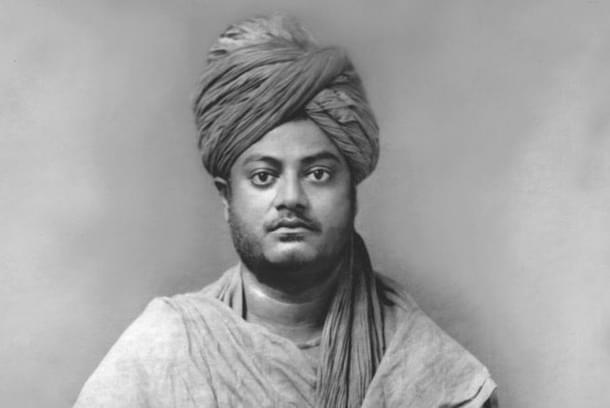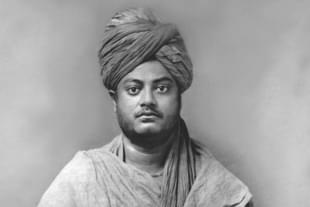Culture
The Mysticism of Swami Vivekananda
Rajarshi Nandy
Nov 20, 2014, 11:52 PM | Updated Feb 10, 2016, 05:50 PM IST
Save & read from anywhere!
Bookmark stories for easy access on any device or the Swarajya app.


In the world of spirituality there are almost always two basic categories of savants: the pure mystics who deal with realms and realities mysterious and supernal, and the intellectual mystics who rationalise the philosophy of spiritual experiences, create systems and organise knowledge, breaking it down so that others — less advanced — may partake in the same journey.
However, in this field, there is never an intellectual without a bit of spiritual mysticism inside. Most of us know of Swami Vivekananda as the great intellectual and scholarly monk who put Hinduism on the world map. Whether one agrees with him on the specifics of his ideas or not, his formidable intellect and vast scholarship, quite rightly, secures his place on a high pedestal in our collective memory. But there was also a mystical aspect to the great Vivekananda, and he did a fantastic job of keeping it wrapped away from the public eye, or generally downplaying it such that even today many are quite unaware of this other side of his.

A few real incidents will prove the point. Emma Calvé was a French opera singer who had met Swami Vivekananda in America. This is how she described that meeting in her autobiography titled “My Life” :
“An appointment was arranged for me, and when I arrived at his house, I was immediately ushered into his study. Before going I had been told not to speak until he addressed me. When I entered the room, therefore, I stood before him in silence for a moment. He was seated in a noble attitude of meditation, his robe of saffron yellow failing in straight lines to the floor, his head swathed in a turban bent forward, his eyes on the ground.
After a brief pause he spoke without looking up. “My child,” he said, “what a troubled atmosphere you have about you! Be calm! It is essential!” Then in quiet voice, untroubled and aloof, this man, who did not even know my name, talked to me of my secret problems and anxieties. He spoke of things that I thought were unknown even to my nearest friends. It seemed miraculous, supernatural! “How do you know all this?” I asked at last. “Who has talked of me to you?” He looked at me with his quiet smile as though I were a child who had asked a foolish question.”
“No one has talked to me,” he answered gently. “Do you think that is necessary? I read you as an open book.”
—-
Once Swami Vivekananda was in Kashi with a few friends, devotees and disciples. One of them, who was clearly unimpressed with what he saw as mere philosophical talk, kept repeating that those ancient mystics of India who had access to supernatural powers and abilities known as siddhis are no where to be found these days. Vivekananda did not comment. The next day when the group arrived to meet him, they found Vivekananda with a pile of small, folded chits of paper.
He asked each of them pick one piece of paper from the pile and keep it with them. Then he told them to ask him any question about themselves whose answer he has no way of knowing. Once the questions were asked Vivekanada told them to open the chits they had picked and check what is written there. To their complete amazement each one of the individual pieces of paper contained the exact and correct answer to the question they had asked!
—–
Another interesting incident comes to us from Paramhamsa Yogananda’s Autobiography of a Yogi. On the night of 24th December 1936 Paramhamsa Yogananda was distributing Christmas gifts to a group of people in Washington. One of the recipients was a Mr Dickinson, who looked visibly shaken on receiving a silver cup that Yogananda had bought from a bazaar in Calcutta. As it turned out, he had good reason to be emotionally shaken on receiving that gift. Many years ago as a child of five years he was on the verge of drowning, when his brother had playfully pushed him into a pool near Nebraska.
At that moment as he kept sinking he suddenly saw a “dazzling multicolored light, filling all space. In the midst was the figure of a man with tranquil eyes and a reassuring smile.” His brother’s friend was finally able to get him out of the pool by throwing a branch. Twelve years later in 1893, as a youth of seventeen, Dickinson visited Chicago with his mother. What happened next can be best described in his own words.
“Mother and I were walking down a main street, when again I saw the mighty flash of light. A few paces away, strolling leisurely along, was the same man I had seen years before in vision. He approached a large auditorium and vanished within the door.
“‘Mother,’ I cried, ‘that was the man who appeared at the time I was drowning!’
“She and I hastened into the building; the man was seated on a lecture platform. We soon learned that he was Swami Vivekananda of India. After he had given a soul-stirring talk, I went forward to meet him. He smiled on me graciously, as though we were old friends. I was so young that I did not know how to give expression to my feelings, but in my heart I was hoping that he would offer to be my teacher. He read my thought.
“‘No, my son, I am not your guru.’ Vivekananda gazed with his beautiful, piercing eyes deep into my own. ‘Your teacher will come later. He will give you a silver cup.’ After a little pause, he added, smiling, ‘He will pour out to you more blessings than you are now able to hold.’
That was the one and only time when Mr Dickinson had met Swami Vivekananda physically. Forty three years later Vivekananda’s prophetic words came true when he received the silver cup from Paramhamsa Yogananda and became a disciple of the famous kriya yogi.
—-
Such special abilities or siddhis as they are known have been traditionally and scripturally an accepted part of Yogic traditions. On the one hand these are said to deter a lesser mortal from the true aims of Yoga, which is realization of the state of Atman and Brahman, yet historically great Yogic masters from across different paramparas have been known to display such extreme and supernatural potencies which they often gain as part of their natural unfolding of their Yogic development.
Behind the mighty intellect of Swami Vivekananda was an extremely accomplished Yogic master well established in the highest states of self realization. There are many such mysterious, inexplicable and interest events that surrounded Swami Vivekananda. He had once declared that had he so wished he could have easily gained and displayed all legendary ashta–Mahasiddhis – eight supernatural Yogic abilities known of Anima, Mahima, Garima, Laghima, Prapti, Prakamya, Istva, Vastva – but that would have defeated the very purpose of his life’s work and teaching. For most parts he took the attitude of an agnostic when it came to supernatural abilities, for Vivekanada’s express aim was to demystify spirituality and religion into as much rational a process as possible, within certain larger ambits. A truly farsighted spiritual visionary.
Rajarshi Nandy is professionally a technical writer based in Mumbai, but spends most of his time in pilgrimage and spiritual exploration.





